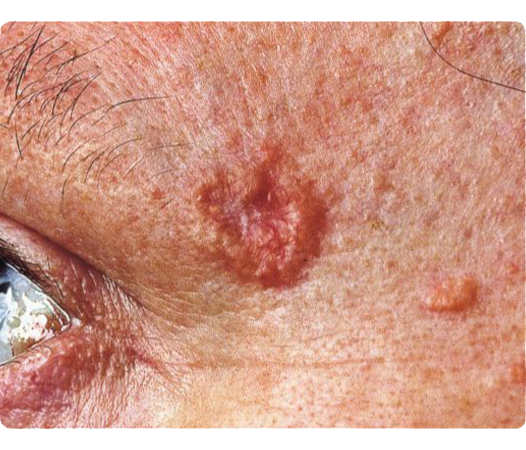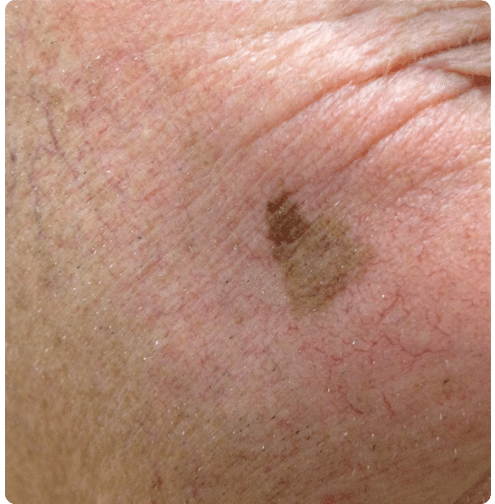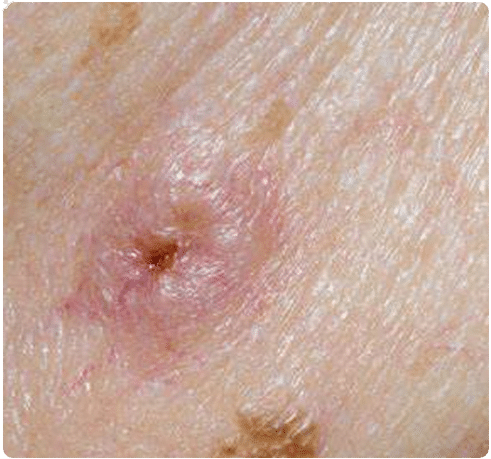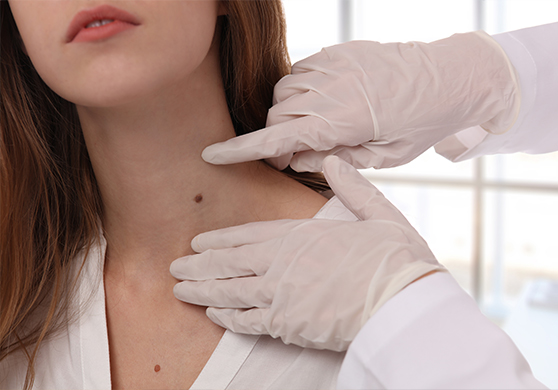What is Skin Cancer?
Your skin is your body’s largest organ, but it’s also unfortunately susceptible to cancer, an abnormal growth of cells. Skin cancer often develops when your skin is exposed to the sun and its harmful ultraviolet rays. The best way to determine if your skin is cancer-free is through a skin checkup. The American Cancer Society recommends a skin cancer-related checkup and counseling about sun exposure as part of any periodic health examination for men and women beginning at age 20.
Types of Skin Cancers

Basil Cell Carcinoma
Basal Cell Carcinoma is the most common form of skin cancer and develops at the base of the outer skin layer, or epidermis. Basal cells typically present as a shiny bump or nodule that is pearly, pink, brown or translucent; an open sore that bleeds, oozes, or crusts and does not heal; or a reddish scaly patch or irritated area. It’s estimated that one in three adults will be diagnosed with a basal cell carcinoma in their lifetime.
Treatment options include electrodesiccation (high-frequency pulses that destroy dangerous tissue), curettage (using a tool called a curette to scrape away cancerous cells), topical chemotherapy creams, excision with stitches, Mohs micrographic surgery, and radiation. Treatment choice depends on the type of basal cell carcinoma, location, size, and age of the patient.

Melanoma
Melanoma originates from melanocytes, or tanning cells. If caught early, it’s almost 100% curable — but if not treated promptly, it may spread and can be fatal. Melanoma is the most common form of cancer for young adults aged 25 to 29 and is increasing faster in females aged 15 to 29 than males in the same age group. Cases of melanoma have increased in the past 30 years, and it’s most frequently found in the torso, which might be due to high-risk tanning behaviors. Other risk factors for melanoma include history of a lot of sun exposure including sunburns, fair skin, light hair, and blue eyes, many moles and freckles, and a family history of melanoma. Excessive sunlight is the primary cause of melanoma.
Surgery is the only cure for melanoma. An area of normal skin around the melanoma is excised to make sure all the cancer is removed. Sometimes, lymph nodes are also biopsied. If the cancer has metastasized, you may require further surgery, radiation, chemotherapy, or immunotherapy.

Squamous Cell Carcinoma
Squamous Cell Carcinoma is the second most common form of skin cancer, which arises in the outermost portion of the skin, called the epidermis. Anyone with a substantial history of sun exposure can develop squamous cell carcinoma. Especially at risk are people that are older; have fair skin; have light eyes; or have occupations or hobbies that primarily take place in the sun. Immunosuppressed individuals, especially organ transplant patients, are also at high risk.
We have options to treat squamous cell carcinoma, including electrodesiccation, standard surgical excision, Mohs micrographic surgery, topical chemotherapy creams, radiation, and curettage. During a curettage session, we use a tool, known as a curette, to scrape out cancerous cells and tissues. It also uses high frequency electric impulse bursts to eliminate any surviving cells or tissues with cancer.
Basil Cell Carcinoma

Basil Cell Carcinoma
Basal Cell Carcinoma is the most common form of skin cancer and develops at the base of the outer skin layer, or epidermis. Basal cells typically present as a shiny bump or nodule that is pearly, pink, brown or translucent; an open sore that bleeds, oozes, or crusts and does not heal; or a reddish scaly patch or irritated area. It’s estimated that one in three adults will be diagnosed with a basal cell carcinoma in their lifetime.
Treatment options include electrodesiccation (high-frequency pulses that destroy dangerous tissue), curettage (using a tool called a curette to scrape away cancerous cells), topical chemotherapy creams, excision with stitches, Mohs micrographic surgery, and radiation. Treatment choice depends on the type of basal cell carcinoma, location, size, and age of the patient.
Melanoma

Melanoma
Melanoma originates from melanocytes, or tanning cells. If caught early, it’s almost 100% curable — but if not treated promptly, it may spread and can be fatal. Melanoma is the most common form of cancer for young adults aged 25 to 29 and is increasing faster in females aged 15 to 29 than males in the same age group. Cases of melanoma have increased in the past 30 years, and it’s most frequently found in the torso, which might be due to high-risk tanning behaviors. Other risk factors for melanoma include history of a lot of sun exposure including sunburns, fair skin, light hair, and blue eyes, many moles and freckles, and a family history of melanoma. Excessive sunlight is the primary cause of melanoma.
Surgery is the only cure for melanoma. An area of normal skin around the melanoma is excised to make sure all the cancer is removed. Sometimes, lymph nodes are also biopsied. If the cancer has metastasized, you may require further surgery, radiation, chemotherapy, or immunotherapy.
Squamous Cell Carcinoma

Squamous Cell Carcinoma
Squamous Cell Carcinoma is the second most common form of skin cancer, which arises in the outermost portion of the skin, called the epidermis. Anyone with a substantial history of sun exposure can develop squamous cell carcinoma. Especially at risk are people that are older; have fair skin; have light eyes; or have occupations or hobbies that primarily take place in the sun. Immunosuppressed individuals, especially organ transplant patients, are also at high risk.
We have options to treat squamous cell carcinoma, including electrodesiccation, standard surgical excision, Mohs micrographic surgery, topical chemotherapy creams, radiation, and curettage. During a curettage session, we use a tool, known as a curette, to scrape out cancerous cells and tissues. It also uses high frequency electric impulse bursts to eliminate any surviving cells or tissues with cancer.
How Do You Check for Skin Cancer? Skin Checks!
Wilmington Dermatology Center’s yearly skin check is one of the simplest doctor’s visits you’ll ever have. Our expert team will check you from head to toe to evaluate your skin health and determine if we need to take a skin sample. Sample collection is fast and painless: we use a numbing agent on the target area so you’ll only feel a slight pinch! This quick test can help save your life, because we can treat almost any skin condition if we catch it early enough.



The ABCs of Our Skin Checks
A Stands for Asymmetry — one half unlike the other half
B stands for Border — irregular, scalloped, or poorly defined border
C stands for COLOR — varied from one area to another; shades of tan, brown and black; sometimes white, red, or blue
D stands for DIAMETER — melanomas are usually greater than 6mm (the size of a pencil eraser) when diagnosed, but they can be smaller
E stands for EVOLVING — a mole or skin lesion that looks different from the rest, or is changing in size, shape, or color
What Can I Do to Protect Myself from Skin Cancer?
We all know too much sun isn’t great for our skin, but it’s easy to underestimate how much damage it can do — or overestimate how easy it is to stay safe! Using protective clothing such as sunglasses, cover-ups and SPF shirts, and wide-brimmed hats helps to shield your skin from the sun’s UV rays. We also recommend using a 30+ SPF mineral-based sunscreen that has “broad spectrum” on the label and is water resistant for at least 80 minutes. Get yourself in the shade as much as possible when spending significant time outdoors. And finally — get regular skin checks with us!

